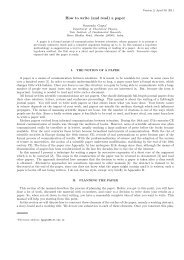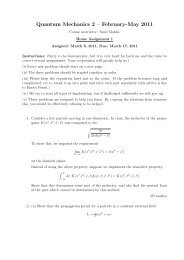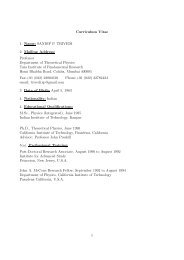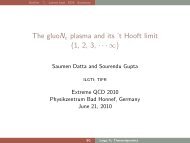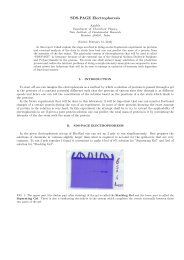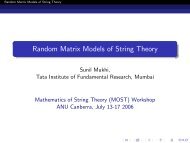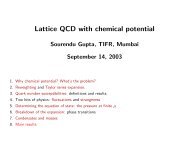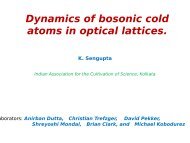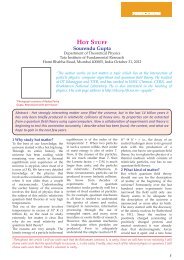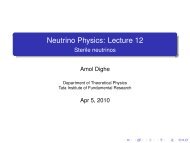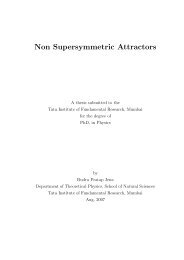Supernova Neutrinos - Department of Theoretical Physics
Supernova Neutrinos - Department of Theoretical Physics
Supernova Neutrinos - Department of Theoretical Physics
Create successful ePaper yourself
Turn your PDF publications into a flip-book with our unique Google optimized e-Paper software.
JIGSAW 2010<br />
Joint Indo-German <strong>Supernova</strong> Astroparticle <strong>Physics</strong> Workshop<br />
Mumbai, 22-26 February 2010<br />
SUPERNOVA NEUTRINOS:<br />
CHALLENGES AND OPPORTUNITIES<br />
Alessandro MIRIZZI<br />
(Universität Hamburg)
OUTLINE<br />
<strong>Supernova</strong>e as neutrino source<br />
<strong>Supernova</strong> neutrino observations: SN 1987A<br />
and future perspectives<br />
<strong>Supernova</strong> neutrino oscillations and observable<br />
signatures<br />
Conclusions
NEUTRINOS<br />
Neutrino oscillations<br />
<strong>Neutrinos</strong> have a tiny but finite mass
NEUTRINO SOURCES<br />
Alessandro Mirizzi JIGSAW 2010 Mumbai, 22-02-2010
WHY SUPERNOVA NEUTRINOS?<br />
SN EXPLOSION: the most powerful neutrino<br />
source (10 57 /10 sec) in the Universe<br />
Neutrino theory/phenomenology<br />
NEUTRINO OSCILLATIONS in extreme<br />
astrophysical environment. Sensitivity to n mixing<br />
Neutrino detection<br />
High-statistics <strong>of</strong> events in large underground<br />
detectors (10 5 -10 6 ev/10 sec) for galactic SN<br />
Neutrino astrophysics<br />
Crucial role <strong>of</strong> n in the explosion mechanism.<br />
Unique probe <strong>of</strong> the deepest SN regions<br />
Neutrino nuclear astrophysics<br />
Nucleosynthesis in supernovae is a neutrinodriven<br />
process
SUPERNOVA NEUTRINOS<br />
Core collapse SN corresponds to the terminal phase <strong>of</strong> a massive star [M ≳ 8 M ]<br />
which becomes unstable at the end <strong>of</strong> its life. It collapses and ejects its outer<br />
mantle in a shock wave driven explosion.<br />
n<br />
n<br />
n<br />
• ENERGY SCALES: 99% <strong>of</strong> the<br />
released energy (~ 10 53 erg) is<br />
emitted by n and n <strong>of</strong> all flavors,<br />
with typical energies E ~ O(15 MeV).<br />
n<br />
n<br />
• TIME SCALES: Neutrino emission<br />
lasts ~10 s<br />
n<br />
n<br />
• EXPECTED: 1-3 SN/century in our<br />
galaxy (d O (10) kpc).<br />
n<br />
Alessandro Mirizzi JIGSAW 2010 Mumbai, 22-02-2010
Stellar Collapse and <strong>Supernova</strong> Explosion<br />
Main-sequence Onion structure star<br />
Helium-burning Collapse (implosion) star<br />
Degenerate iron core:<br />
r 10 9 g cm -3<br />
Hydrogen T 10 10 Burning K<br />
M Fe 1.5 M sun<br />
R Fe 8000 km<br />
Helium Hydrogen<br />
Burning Burning<br />
[slides from G. Raffelt]
Stellar Collapse and <strong>Supernova</strong> Explosion<br />
Newborn Neutron Star<br />
Collapse Explosion (implosion)<br />
~ 50 km<br />
Neutrino<br />
Cooling<br />
Proto-Neutron Star<br />
r r nuc = 3 10 14 g cm -3<br />
T 30 MeV
TYPICAL PROBLEMS IN SUPERNOVA NEUTRINOS<br />
Core Collapse<br />
EARTH<br />
|<br />
Production (flavor) Propagation (mass,mixing) Detection (flavor)<br />
exp( -iHt)<br />
| | | | f<br />
i<br />
- Simulations <strong>of</strong> SN explosion<br />
- Initial energy spectra<br />
- Initial time spectra<br />
<br />
- Matter effects: shock<br />
wave,turbulences, Earth<br />
crossing, …<br />
- Dense neutrino bkg<br />
- New interactions<br />
- Decays<br />
- ………<br />
Theory<br />
Phenomenology<br />
<br />
- CC & NC interactions<br />
- Different detectors<br />
- Energy spectra<br />
- Angular spectra<br />
- Time spectra
ACCRETION<br />
COOLING<br />
Neutrino fluxes (in time)<br />
Alessandro Mirizzi JIGSAW 2010 Mumbai, 22-02-2010<br />
NEUTRONIZATION<br />
Results <strong>of</strong> neutrino emission based on the<br />
numerical simulations <strong>of</strong> SN explosion. [see,<br />
e.g., T. Totani, K.Sato, H.E. Dalhed, and J.R. Wilson,<br />
Astrophys. J. 496, 216 (1998)].<br />
• NEUTRONIZATION BURST: n e<br />
• Duration: ~ 25 ms after the<br />
explosion<br />
• Emitted energy : E~ 10 51<br />
(1/100 <strong>of</strong> total energy)<br />
erg<br />
• THERMAL BURST (ACCRETION +<br />
COOLING): n e , n e , n x , n x<br />
• Accretion: ~ 0.5 s<br />
• Cooling: ~ 10 s<br />
• Emitted energy: E~ 10 53<br />
erg
Neutrino spectra (in energy)<br />
“quasi-thermal” spectra<br />
Hierarchy <strong>of</strong> the spectra<br />
E<br />
E<br />
E<br />
e<br />
e<br />
x<br />
9 -12 MeV<br />
14 -17 MeV<br />
18 -22 MeV<br />
Alessandro Mirizzi JIGSAW 2010 Mumbai, 22-02-2010
NEW LONG-TERM COOLING CALCULATIONS<br />
[Talks by Cardall, Ott, Raffelt]<br />
After many efforts ……<br />
New Garching simulation, Hüdepol et al., 0912.0260<br />
Low-mass ( ̴ 8 M ) SNe<br />
start to explode also in<br />
computer !!<br />
See also new Basel<br />
simulations, Fischer et al.,<br />
0908.1871
Sanduleak -69 202<br />
<strong>Supernova</strong> 1987A<br />
23 February 1987<br />
Tarantula Nebula<br />
Large Magellanic Cloud<br />
Distance 50 kpc<br />
(160.000 light years)
Neutrino Burst Observation :<br />
First verification <strong>of</strong> stellar evolution mechanism<br />
Neutrino Astronomy
Energy Distribution <strong>of</strong> SN 1987A <strong>Neutrinos</strong><br />
Kamiokande-II (Japan)<br />
Water Cherenkov detector<br />
2140 tons<br />
Irvine-Michigan-Brookhaven (US)<br />
Water Cherenkov detector<br />
6800 tons<br />
Alessandro Mirizzi JIGSAW 2010 Mumbai, 22-02-2010
Total binding energy<br />
Interpreting SN1987A neutrinos<br />
[e.g.,B. Jegerlehner, F. Neubig and G. Raffelt, PRD 54, 1194 (1996); A.M., and G. Raffelt,<br />
PRD 72, 063001 (2005)]<br />
• Imposing thermal n spectra, tension<br />
between the two experiments<br />
(marginal overlap between the two<br />
separate CL)<br />
• Tension between the experiments<br />
and the theory.<br />
Theory<br />
But….<br />
Average n e<br />
energy<br />
Alessandro Mirizzi JIGSAW 2010 Mumbai, 22-02-2010
NEW LONG-TERM COOLING CALCULATION<br />
Lower n average energies…In agreement with SN 1987A data<br />
Fischer et al. (Basel group), arXiv: 0908.1871
SN NEUTRINO SPECTRUM FROM SN1987A<br />
[Yuksel & Beacom, astro-ph/0702613]<br />
Original SN n energy spectra expected<br />
to be quasi-thermal<br />
SN1987A inferred n energy spectrum<br />
shows strong deviations from quasithermal<br />
distribution:<br />
Possible effects <strong>of</strong>:<br />
• neutrino mixing<br />
• n-n interactions<br />
• n decay<br />
• nonstandard n interactions<br />
• additional channels <strong>of</strong> energy<br />
exchange among flavors<br />
?<br />
Possible to reconcile detection and theory… Still many open questions!
What could we see “tomorrow”?<br />
SN 20XXA !
Large Detectors for <strong>Supernova</strong> <strong>Neutrinos</strong><br />
MiniBooNE (200)<br />
LVD (400)<br />
Borexino (80)<br />
Super-Kamiokande (10 4 )<br />
KamLAND (330)<br />
[Talks by Griesel,<br />
Kowarik, Virtue,<br />
Yen, Vagins]<br />
IceCube<br />
In brackets events<br />
for a “fiducial SN”<br />
at distance 10 kpc
Simulated <strong>Supernova</strong> Signal at Super-Kamiokande<br />
Accretion phase<br />
Cooling phase<br />
Simulation for Super-Kamiokande SN signal at 10 kpc,<br />
based on a numerical Livermore model<br />
[Totani, Sato, Dalhed & Wilson, ApJ 496 (1998) 216]
Simulated <strong>Supernova</strong> Signal at Ice-Cube<br />
[Dighe, Keil and Raffelt, hep-ph/0303210]<br />
LIVERMORE<br />
GARCHING<br />
Possible to reconstruct the SN n lightcurve with current detectors.<br />
Discrimination btw different simulations.
SIGNALS OF QCD PHASE TRANSITION IN SN n<br />
[Sagert et al., arXiv:0809.4225, Dasgupta et al. 0912.2568]<br />
If QCD phase transition happens in a<br />
SN → second peak in the neutrino<br />
signal.<br />
In contrast to the first neutronization<br />
burst, second neutrino burst<br />
dominated by the emission <strong>of</strong> antineutrinos<br />
Alessandro Mirizzi JIGSAW 2010 Mumbai, 22-02-2010
SN n DETECTORS AS QCD EXPERIMENTS<br />
[Dasgupta et al, arXiv:0912.2568]<br />
ICE-CUBE<br />
[Talk by Dasgupta]<br />
SUPER-KAMIOKANDE<br />
While the standard n e neutronization burst is difficult to detect with current<br />
detectors, the QCD-induced n e peak would be successfully tracked by IBD<br />
reactions.<br />
Alessandro Mirizzi JIGSAW 2010 Mumbai, 22-02-2010
Next generation Detectors for <strong>Supernova</strong> <strong>Neutrinos</strong><br />
Next-generation large volume detectors might open a new era in SN<br />
neutrino detection:<br />
• 0.4 Mton WATER Cherenkov detectors<br />
• 100 kton Liquid Ar TPC<br />
• 50 kton scintillator<br />
Mton Cherenkov<br />
LAr TPC<br />
Scintillator<br />
UNO, MEMPHYS, HYPER-K<br />
GLACIER<br />
LENA<br />
See LAGUNA Collaboration, “Large underground, liquid based detectors for astro-particle<br />
physics in Europe: Scientific case and prospects,” arXiV:0705.0116 [hep-ph]
0.4 Mton Water Cherenkov detector<br />
[ Fogli, Lisi, A.M., Montanino, hep-ph/0412046]<br />
Golden channel: Inverse beta decay<br />
(IBD) <strong>of</strong> n e<br />
~2.5×10 5 events @ 10 kpc<br />
Alessandro Mirizzi JIGSAW 2010 Mumbai, 22-02-2010
NEUTRONIZATION BURST<br />
WC<br />
Lar TPC<br />
I.H.<br />
N.H.<br />
N=182<br />
70 kton<br />
N=110<br />
sin 2 q 13 =<br />
1 Mton<br />
n e,x e - n e,x e -<br />
[M.Kachelriess & R. Tomas, hep-ph/0412082]<br />
[I.Gil-Botella & A.Rubbia, hep-ph/0307244]<br />
• Robust feature <strong>of</strong> SN simulations<br />
• Possibility to probe oscillation physics during early stages <strong>of</strong> a SN<br />
• SN distance measurement (with a precision <strong>of</strong> ~5 %): N~ 1/d 2 . Useful in<br />
case <strong>of</strong> dust oscuration.
Next-generation detectors would assure a high-statistics measurement <strong>of</strong><br />
galactic SN neutrinos.<br />
This would allow spectral studies<br />
• in time<br />
• in energy<br />
• in different interaction channels<br />
We will mainly focus on the possibility to detect signatures in the n signal for<br />
a typical galactic SN explosion associated to<br />
SN NEUTRINO OSCILLATIONS<br />
Alessandro Mirizzi JIGSAW 2010 Mumbai, 22-02-2010
SN n FLAVOR TRANSITIONS<br />
The flavor evolution in matter is described by the non-linear MSW<br />
equations:<br />
d<br />
i = H H H<br />
<br />
vac e<br />
dx n nn n<br />
<br />
<br />
In the standard 3n framework<br />
H<br />
vac<br />
=<br />
U M U<br />
2E<br />
2 †<br />
Kinematical mass-mixing term<br />
H = 2G diag( N ,0,0)<br />
e F e<br />
Hnn = 2 G F<br />
(1 -cos q<br />
pq)<br />
rq - rq<br />
dq<br />
<br />
<br />
Dynamical MSW term (in matter)<br />
Neutrino-neutrino interactions term<br />
(non-linear)<br />
Alessandro Mirizzi JIGSAW 2010 Mumbai, 22-02-2010
VACUUM OSCILLATIONS<br />
Two flavor mixing<br />
n<br />
e cosq<br />
sinq<br />
n1<br />
<br />
=<br />
n<br />
<br />
<br />
-sinq<br />
cosqn<br />
2 <br />
Each mass eigenstates propagates as e ipz with<br />
-ip1z<br />
-ip2z<br />
n ( z) = -sin q e n cos q e n<br />
<br />
2 n oscillation probability<br />
2<br />
mi<br />
= - -<br />
2E<br />
2 2<br />
pi<br />
E m E<br />
1 2<br />
2<br />
2<br />
2 2mL<br />
P( n<br />
e<br />
n<br />
) = n<br />
( z) n<br />
e(0) = sin 2q<br />
sin <br />
Bruno Pontecorvo (1967)<br />
<br />
4E<br />
<br />
Alessandro Mirizzi JIGSAW 2010 Mumbai, 22-02-2010
3n FRAMEWORK<br />
Mixing parameters: U = U (q 12 , q 13 , q 23 , d as for CKM matrix<br />
-id<br />
ne<br />
1<br />
<br />
c13 e s <br />
13 c12 s12 n1<br />
<br />
<br />
<br />
n<br />
= c23 s23 1 <br />
-s12 c12 <br />
n2<br />
-id<br />
n <br />
<br />
s23 c <br />
23<br />
e s13 c 13<br />
1n<br />
<br />
- -<br />
3 <br />
c 12 = cos q 12 , etc., d CP phase<br />
Mass-gap parameters: M 2 = - dm2 , + dm 2<br />
, ± m<br />
2 2<br />
2<br />
“solar”<br />
“atmospheric”<br />
n 3<br />
inverted hierarchy<br />
m 2 -m 2<br />
n 1 n 1<br />
n 2 n 2<br />
dm 2 /2<br />
-dm 2 /2<br />
dm 2 /2<br />
-dm 2 /2<br />
normal hierarchy<br />
n 3<br />
Alessandro Mirizzi JIGSAW 2010 Mumbai, 22-02-2010
GLOBAL OSCILLATION ANALYSIS (2008)<br />
[Fogli et al., arXiv:0805.2517]
MIKHEYEV-SMIRNOV-WOLFENSTEIN (MSW) EFFECT<br />
[Wolfenstein, PRD 17, 2369 (1978)]<br />
When neutrinos propagate in a medium they will experience a shift <strong>of</strong> their<br />
energy, similar to photon refraction, due to their coherent interaction with the<br />
medium constituents<br />
n e e ±<br />
n<br />
n e,,<br />
e,,<br />
W ± Z 0<br />
e ± n e<br />
Charged current<br />
f<br />
Neutral current<br />
The difference <strong>of</strong> the interaction energy <strong>of</strong> different flavors gives an<br />
effective potential for electron (anti)neutrinos<br />
f<br />
V( x) = 2G F<br />
N e<br />
net electron density
MSW MATTER EFFECT IN SN<br />
[Tomas et al., astro-ph/0407132]<br />
A few second after the core<br />
bounce, shock wave(s) can<br />
induce time-dependent matter<br />
effects in neutrino oscillations<br />
[R.Schirato, and G. Fuller, astroph/0205390]<br />
Shock front<br />
Neutrino oscillations as a<br />
“camera” for shock-wave<br />
propagation<br />
[see, e.g., Fogli, Lisi, A.M., and Montanino, hep-ph/0304056; Fogli, Lisi, A.M., and Montanino, hepph/0412046,<br />
Tomas et al., astro-ph/0407132, Choubey et al, hep-ph/0605255 ]
events/bin<br />
PROBING SHOCK WAVES AND MASS HIERARCHY<br />
AT LARGE q 13<br />
Time spectra <strong>of</strong> n e (p,n)e +<br />
0.4 Mton Cherenkov<br />
fwd shock<br />
sin 2 q 13 =10 -2<br />
In inverted hierarchy and for q 13 not<br />
too small, flavor conversions along<br />
the shock-waves induce nonmonotonic<br />
time spectra at<br />
“sufficiently high” energy.<br />
[Fogli, Lisi, A.M., and Montanino, hep-ph/0412046]<br />
Alessandro Mirizzi JIGSAW 2010 Mumbai, 22-02-2010
Alessandro Mirizzi JIGSAW 2010 Mumbai, 22-02-2010<br />
STOCHASTIC DENSITY FLUCTUATIONS<br />
A SN neutrino “beam” might experience<br />
stochastic matter effects while<br />
traversing the stellar envelope.<br />
SHADOW ON THE SHOCK-WAVE<br />
SIGNATURE<br />
[Fogli, Lisi, A.M. , Montanino, hepph/0603033;<br />
Friedland, astroph/0607244;<br />
Choubey, Harries, Ross,<br />
hep-ph/0703092]
NEUTRINO-NEUTRINO INTERACTIONS<br />
In the region just above the neutrino-sphere the neutrino density exceeds the ordinary<br />
electron background. <strong>Neutrinos</strong> themeselves form a background medium<br />
n-n NC interactions important!<br />
• Matter bkg potential<br />
V<br />
V<br />
=<br />
• n-n potential<br />
=<br />
2G F<br />
N e<br />
2Gn F n<br />
V
SN SELF-INTERACTION POTENTIAL AND MATTER<br />
POTENTIAL<br />
r < 200 km : Self-induced collective oscillations<br />
r > 200 km : Ordinary MSW effects<br />
Alessandro Mirizzi JIGSAW 2010 Mumbai, 22-02-2010
SYNCHRONIZED OSCILLATIONS BY NEUTRINO-<br />
NEUTRINO INTERACTIONS<br />
Example: evolution <strong>of</strong> neutrino momenta with a thermal distribution<br />
<br />
LARGE NEUTRINO DENSITY<br />
If neutrino density dominates,<br />
synchronized oscillations with a<br />
characteristic common oscillation<br />
frequency<br />
[Pastor, Raffelt, Semikoz, hep-ph/0109033]
PENDULAR OSCILLATIONS<br />
[Hannestad, Raffelt, Sigl, Wong, astro-ph/0608695]<br />
Equal densities <strong>of</strong> n and n<br />
INVERTED HIERARCHY + small θ<br />
In inverted hierarchy: coherent “pair conversion” n e n e<br />
n n <br />
With constant : periodic behaviour<br />
Alessandro Mirizzi JIGSAW 2010 Mumbai, 22-02-2010
PENDULUM IN FLAVOR SPACE<br />
[Hannestad, Raffelt, Sigl, Wong, astro-ph/0608695, Duan, Carlson, Fuller, Qian, astro-ph/0703776]<br />
Neutrino mass hierarchy (and q 13 ) set initial condition and fate<br />
• Normal hierarchy<br />
Pendulum starts in ~ downard (stable)<br />
positions and stays nearby. No significant<br />
flavor change.<br />
Normal hierarchy<br />
• Inverted hierarchy<br />
Pendulum starts in ~ upward (unstable)<br />
positions and eventually falls down.<br />
Significant flavor changes.<br />
Inverted hierarchy<br />
q 13 sets initial misalignment with vertical. Specific value not much relevant.<br />
Alessandro Mirizzi JIGSAW 2010 Mumbai, 22-02-2010
synchronization<br />
SUPERNOVA TOY-MODEL<br />
[Hannestad, Raffelt, Sigl, Wong, astro-ph/0608695]<br />
Only n e and n e<br />
Pendular<br />
conversions<br />
SUPERNOVA: Non-periodic since n density decreases<br />
Complete flavor conversions!<br />
• Occurs for very small mixing angles<br />
• Almost independent <strong>of</strong> the presence <strong>of</strong> dense normal<br />
matter<br />
• Preserves the initial excess n e over n e (lepton number conservation)<br />
Alessandro Mirizzi JIGSAW 2010 Mumbai, 22-02-2010
NEUTRINO FLUX NUMBERS<br />
[Raffelt et al. (Garching group), astro-ph/0303226]<br />
n e<br />
n e<br />
n x<br />
Accretion phase<br />
Cooling phase<br />
F<br />
ne<br />
<br />
F<br />
ne<br />
<br />
F<br />
nx<br />
F<br />
nx<br />
<br />
F<br />
ne<br />
<br />
F<br />
ne<br />
Excess <strong>of</strong> n e due to<br />
deleponization<br />
Moderate flavor hierarchy,<br />
possible excess <strong>of</strong> n x
Inverted mass<br />
hierarchy<br />
SPECTRAL SPLITS IN THE ACCRETION PHASE<br />
[Fogli, Lisi, Marrone, A.M. , arXiV: 0707.1998 [hep-ph], Duan, Carlson, Fuller, Qian, astroph/0703776,<br />
Raffelt and Smirnov, 0705.1830 [hep-ph]]<br />
Initial fluxes at<br />
neutrinosphere (r ~10 km)<br />
F : F : F 2.4 :1.6 :1.0<br />
n e n e n x<br />
=<br />
(ratio typical <strong>of</strong> accretion phase)<br />
Fluxes at the end <strong>of</strong> collective<br />
effects (r ~200 km)<br />
Nothing happens in NH
MULTIPLE SPECTRAL SPLITS IN THE COOLING PHASE<br />
[Dasgupta, Dighe, Raffelt & Smirnov, arXiv:0904.3542 [hep-ph]]<br />
x<br />
e<br />
F : F : F 0.85: 0.75:1.00<br />
n e n e n x<br />
=<br />
(typical in cooling phase)<br />
Splits possible in both normal and<br />
inverted hierarchy, for n & n !!<br />
Possible time-dependent signatures<br />
in the SN n signal<br />
Crucial both n and n detection<br />
[See also Fogli, Lisi, Marrone, Tamborra, arXiV:0907.5115]<br />
[Talks by Dasgupta, Marrone]<br />
Alessandro Mirizzi JIGSAW 2010 Mumbai, 22-02-2010
THREE FLAVOR EFFECTS IN THE COOLING PHASE<br />
[Friedland, 1001.0996; Dasgupta, A.M., Tamborra, Tomas, 1002.2943]<br />
Inverted hierarchy<br />
Normal hierarchy<br />
IN IH hierarchy three-flavor effects associated to the solar mass<br />
difference can erase the high-energy spectral split<br />
[Talk by Dasgupta]<br />
Only subleading effect in NH<br />
Alessandro Mirizzi JIGSAW 2010 Mumbai, 22-02-2010
USING EARTH EFFECT TO DIAGNOSE COLLECTIVE<br />
OSCILLATIONS<br />
Earth matter crossing induces additional n conversions between n 1 and n 2<br />
mass eigenstates. The main signature <strong>of</strong> Earth matter effects – oscillatory<br />
modulations <strong>of</strong> the observed energy spectra – is unambiguous since it can<br />
not be mimicked by known astrophysical phenomena<br />
n e + p → n + e +<br />
Alessandro Mirizzi JIGSAW 2010 Mumbai, 22-02-2010
MASS HIERARCHY DETERMINATION AT EXTREMELY SMALL q 13<br />
[Dasgupta, Dighe, A.M., arXiv:0802.1481 [hep-ph]]<br />
(Accretion phase)<br />
Ratio <strong>of</strong> spectra in two<br />
water Cherenkov<br />
detectors (0.4 Mton),<br />
one shadowed by the<br />
Earth, the other not.<br />
R<br />
=<br />
F<br />
- F<br />
shadowed unshadowed<br />
e<br />
e<br />
unshadowed<br />
Fe<br />
Alessandro Mirizzi JIGSAW 2010 Mumbai, 22-02-2010
COLLECTIVE SUPERNOVA NEUTRINO OSCILLATIONS<br />
(2006-2010)<br />
“Bipolar” collective transformation important, also for dense matter: Duan, Fuller<br />
& Qian, astro-ph/0511275<br />
Numerical simulations including multi-angle effects. Discovery <strong>of</strong> the spectral<br />
split: Duan, Fuller, Carlson & Qian, astro-ph/0606616, 0608050<br />
Pendulum in flavor space: Hannestad, Raffelt, Sigl & Wong, astro-ph/0608695,<br />
Duan, Fuller, Carlson & Qian, astro-ph/0703776<br />
Multi-angle decoherence: Sawyer, hep-ph/0408265, 0503013. Raffelt & Sigl, hepph/0701182,<br />
Esteban-Pretel, Pastor, Tomas, Raffelt & Sigl, arXiv:0706.2498<br />
Theory <strong>of</strong> spectral split in terms <strong>of</strong> adiabatic solution: Raffelt & Smirnov, arXiv:<br />
0705.1830, 0709.0641; Duan, Fuller, Carlson & Qian, arXiv: 0706.4293, 0707.0290<br />
Independent multi-angle numerical simulations: Fogli, Lisi, Marrone & A.M., arXiv:<br />
0707.1998, Fogli, Lisi, Marrone, A.M & Tamborra, arXiv:0808.0807<br />
Three flavor effects in O-Ne-Mg SNe: Duan, Fuller, Carlson & Qian, arXiv:<br />
0710.1271, Dasgupta, Dighe, A.M. & Raffelt, arXiv: 0801.1660
Theory <strong>of</strong> three flavor collective oscillations: Dasgupta & Dighe, arXiv:0712.3798<br />
Secord order - refractive effect important in the three flavor context:<br />
Esteban-Pretel, Pastor, Tomas, Raffelt & Sigl, arXiv: 0712.1137<br />
Three flavor numerical simulations: Fogli, Lisi, Marrone & Tamborra,<br />
arXiv:0812.3031<br />
CP violation effects: Gava & Volpe, arXiv:0807.3418<br />
Identifying the mass hierarchy at extremely small q 13 : Dasgupta, Dighe, A.M., arXiv:<br />
0802.1481<br />
Formulation for non-spherical geometry: Dasgupta, Dighe, A.M. & Raffelt, arXiv:<br />
0805.3300.<br />
Role <strong>of</strong> dense matter : Esteban-Pretel, A.M. , Pastor, Raffelt, Tomas, Serpico, Sigl,<br />
arXiv: 0807.0659<br />
Nonstandard interactions : Blennow, A.M. , Serpico, arXiv: 0810.2297, Esteban-<br />
Pretel, Tomas & Valle, arXiv: 0909.2196<br />
Neutrino flavor spin waves: Duan, Fuller & Qian, arXiv:0808.2046<br />
Combining collective + MSW effect: Gava,Kneller, Volpe, McLaughlin, arXiv:0902.0317
Multiple spectral splits: Dasgupta, Dighe, Raffelt & Smirnov, arXiv:0904.3543,<br />
Fogli, Lisi, Marrone & Tamborra, arXiv: 0907.5115, Friedland, arXiv:1001.0996,<br />
Dasgupta, A.M., Tamborra, Tomas, arXiV: 1002.2943<br />
Radiative corrections to n-n refractive index: A.M, Raffelt, Pozzorini &<br />
Serpico, arXiv: 0907.3674<br />
SUSY effects: Gava & Jean-Louis, arXiv: 0912.5206<br />
Effects on r-process nucleosynthesis: Chakraborty, Choubey, Goswami, Kar,<br />
arXiv: 0911.1218<br />
Triggering collective oscillations at q 13 =0: Dasgupta, Raffelt, Tamborra, arXiv:<br />
1001.5396<br />
[Talks by Dasgupta, Marrone, Tamborra, Serpico, Tomas, Choubey,<br />
Charkaborty]
<strong>Theoretical</strong> issues<br />
Realistic SN environment<br />
OPEN ISSUES<br />
Robustness <strong>of</strong> the collective behavior vs. multi-angle<br />
decoherence effects. Many-body effects. Reduced<br />
symmetries<br />
How asphericities, inhomogeneities, turbulence during the SN<br />
explosion might influence neutrino-neutrino interaction<br />
effects.<br />
Feedback on SN explosion simulations<br />
Collective effects occur in a crucial region for SN dynamics<br />
and for nucleosynthesis. SN explosion simulations do not<br />
account for neutrino oscillations.<br />
Beyond the SM<br />
Possible new nu-nu interactions beyond SM might pr<strong>of</strong>oundly<br />
change the current picture.
CONCLUSIONS<br />
Observing SN neutrinos is the next frontiers <strong>of</strong> low-energy neutrino<br />
astronomy<br />
The physics potential <strong>of</strong> current and next-generation detectors in<br />
this context is enormous, both for particle physics and<br />
astrophysics.<br />
SN provide very extreme conditions, where the shock-wave,<br />
matter turbulence, neutrino-neutrino interactions prove to be<br />
surprisingly important in the n oscillations.<br />
Further investigations needed to better understand neutrino<br />
flavor conversions during a stellar collapse….
WAITING FOR THE NEXT GALACTIC<br />
SN….
…WE WILL HAVE NO TIME TO<br />
GET BORED !<br />
GOOD JIGSAW 2010<br />
HAVE FUN !<br />
Seminar room @ TIFR, February 2008: Long discussions on collective<br />
oscillations with Amol Dighe and Basudeb Dasgupta






